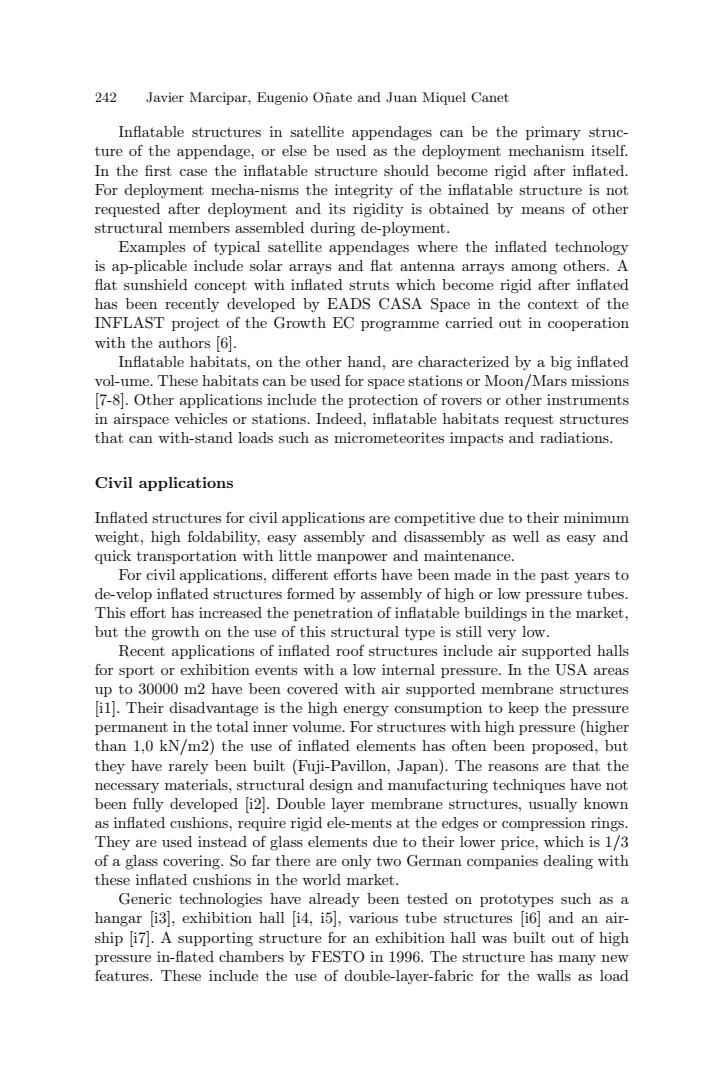正在加载图片...

242 Javier Marcipar,Eugenio Onate and Juan Miquel Canet Inflatable structures in satellite appendages can be the primary struc- ture of the appendage,or else be used as the deployment mechanism itself. In the first case the inflatable structure should become rigid after inflated. For deployment mecha-nisms the integrity of the inflatable structure is not requested after deployment and its rigidity is obtained by means of other structural members assembled during de-ployment. Examples of typical satellite appendages where the inflated technology is ap-plicable include solar arrays and flat antenna arrays among others.A flat sunshield concept with inflated struts which become rigid after inflated has been recently developed by EADS CASA Space in the context of the INFLAST project of the Growth EC programme carried out in cooperation with the authors [6]. Inflatable habitats,on the other hand,are characterized by a big inflated vol-ume.These habitats can be used for space stations or Moon/Mars missions [7-8.Other applications include the protection of rovers or other instruments in airspace vehicles or stations.Indeed,inflatable habitats request structures that can with-stand loads such as micrometeorites impacts and radiations. Civil applications Inflated structures for civil applications are competitive due to their minimum weight,high foldability,easy assembly and disassembly as well as easy and quick transportation with little manpower and maintenance. For civil applications,different efforts have been made in the past years to de-velop inflated structures formed by assembly of high or low pressure tubes. This effort has increased the penetration of infatable buildings in the market, but the growth on the use of this structural type is still very low. Recent applications of inflated roof structures include air supported halls for sport or exhibition events with a low internal pressure.In the USA areas up to 30000 m2 have been covered with air supported membrane structures [il].Their disadvantage is the high energy consumption to keep the pressure permanent in the total inner volume.For structures with high pressure(higher than 1,0 kN/m2)the use of inflated elements has often been proposed,but they have rarely been built (Fuji-Pavillon,Japan).The reasons are that the necessary materials,structural design and manufacturing techniques have not been fully developed [i2].Double layer membrane structures,usually known as inflated cushions,require rigid ele-ments at the edges or compression rings. They are used instead of glass elements due to their lower price,which is 1/3 of a glass covering.So far there are only two German companies dealing with these inflated cushions in the world market. Generic technologies have already been tested on prototypes such as a hangar i3,exhibition hall i4,i5,various tube structures [i6]and an air- ship i7.A supporting structure for an exhibition hall was built out of high pressure in-flated chambers by FESTO in 1996.The structure has many new features.These include the use of double-layer-fabric for the walls as load242 Javier Marcipar, Eugenio O˜nate and Juan Miquel Canet ˜ Inflatable structures in satellite appendages can be the primary structure of the appendage, or else be used as the deployment mechanism itself. In the first case the inflatable structure should become rigid after inflated. For deployment mecha-nisms the integrity of the inflatable structure is not requested after deployment and its rigidity is obtained by means of other structural members assembled during de-ployment. Examples of typical satellite appendages where the inflated technology is ap-plicable include solar arrays and flat antenna arrays among others. A flat sunshield concept with inflated struts which become rigid after inflated has been recently developed by EADS CASA Space in the context of the INFLAST project of the Growth EC programme carried out in cooperation with the authors [6]. Inflatable habitats, on the other hand, are characterized by a big inflated vol-ume. These habitats can be used for space stations or Moon/Mars missions [7-8]. Other applications include the protection of rovers or other instruments in airspace vehicles or stations. Indeed, inflatable habitats request structures that can with-stand loads such as micrometeorites impacts and radiations. Civil applications Inflated structures for civil applications are competitive due to their minimum weight, high foldability, easy assembly and disassembly as well as easy and quick transportation with little manpower and maintenance. For civil applications, different efforts have been made in the past years to de-velop inflated structures formed by assembly of high or low pressure tubes. This effort has increased the penetration of inflatable buildings in the market, but the growth on the use of this structural type is still very low. Recent applications of inflated roof structures include air supported halls for sport or exhibition events with a low internal pressure. In the USA areas up to 30000 m2 have been covered with air supported membrane structures [i1]. Their disadvantage is the high energy consumption to keep the pressure permanent in the total inner volume. For structures with high pressure (higher than 1,0 kN/m2) the use of inflated elements has often been proposed, but they have rarely been built (Fuji-Pavillon, Japan). The reasons are that the necessary materials, structural design and manufacturing techniques have not been fully developed [i2]. Double layer membrane structures, usually known as inflated cushions, require rigid ele-ments at the edges or compression rings. They are used instead of glass elements due to their lower price, which is 1/3 of a glass covering. So far there are only two German companies dealing with these inflated cushions in the world market. Generic technologies have already been tested on prototypes such as a hangar [i3], exhibition hall [i4, i5], various tube structures [i6] and an airship [i7]. A supporting structure for an exhibition hall was built out of high pressure in-flated chambers by FESTO in 1996. The structure has many new features. These include the use of double-layer-fabric for the walls as load